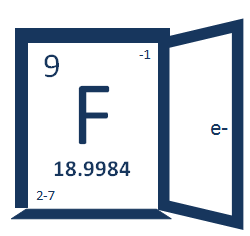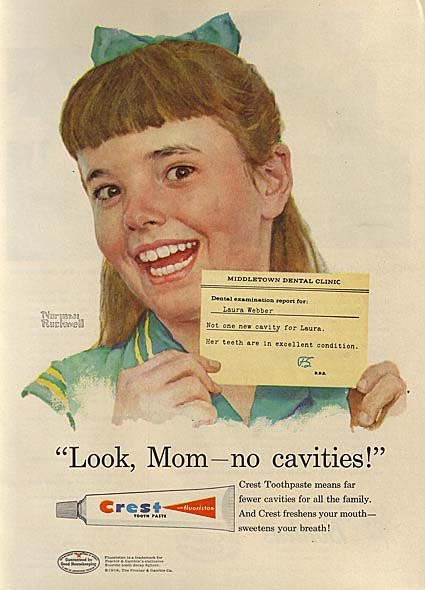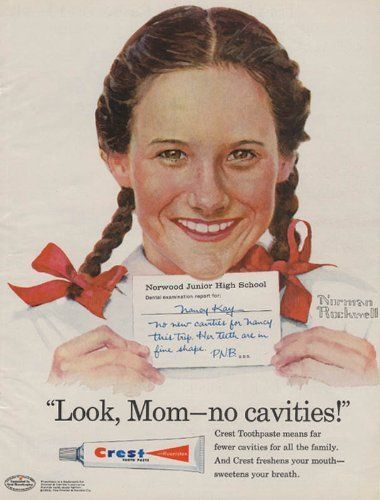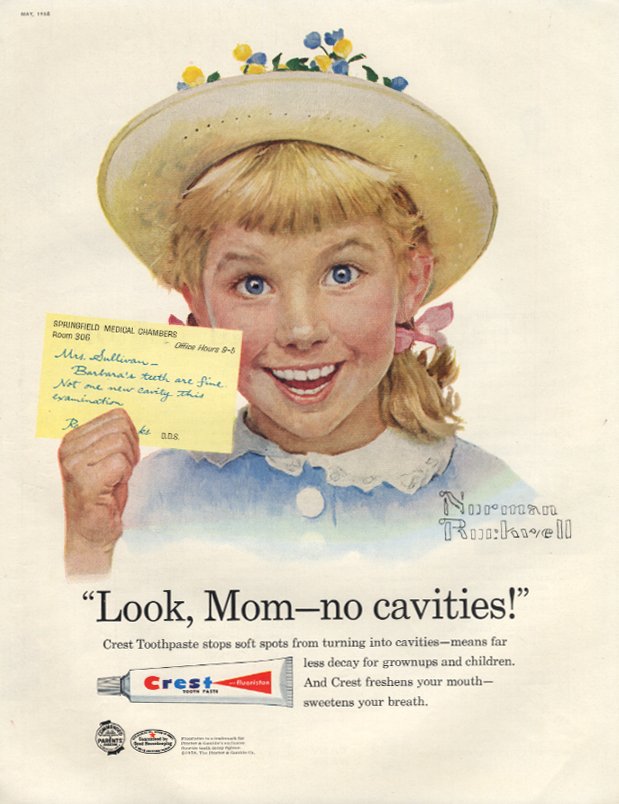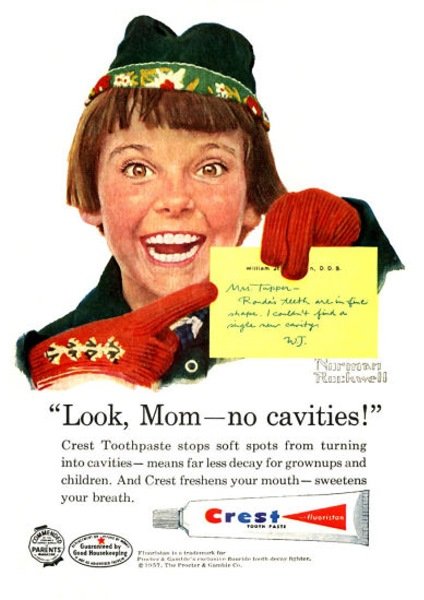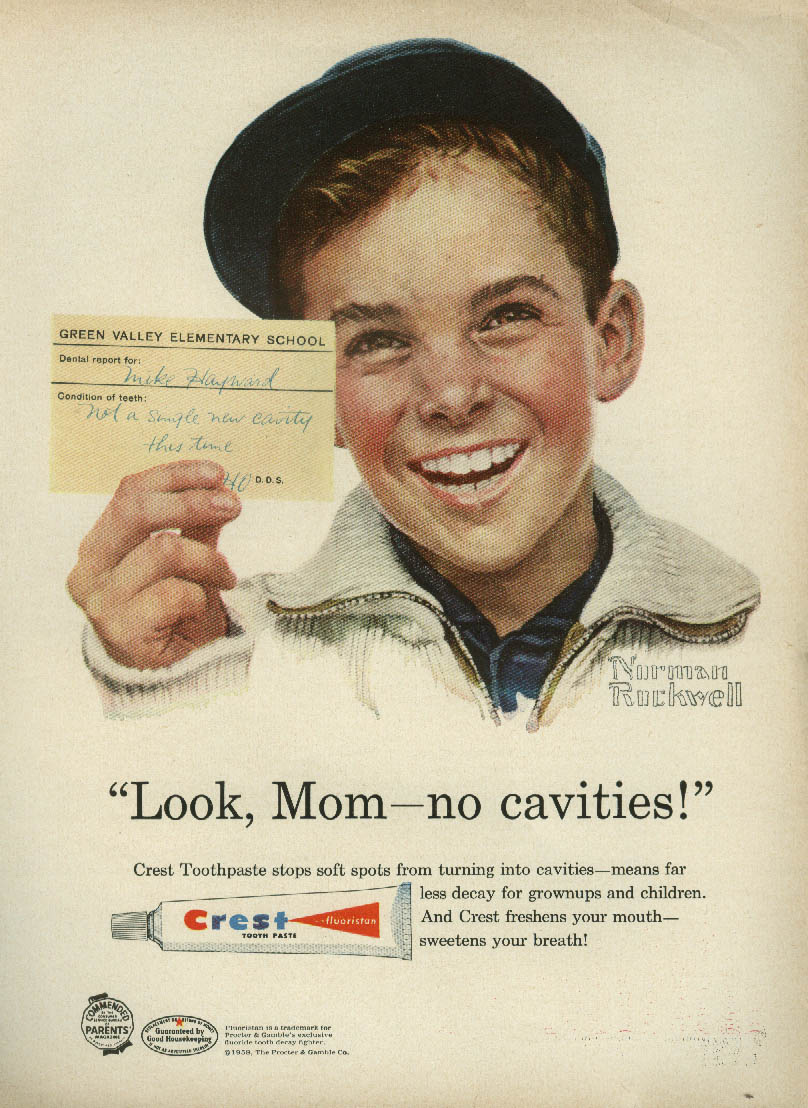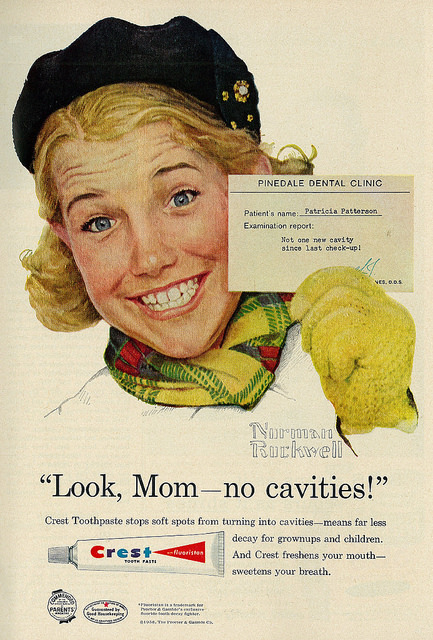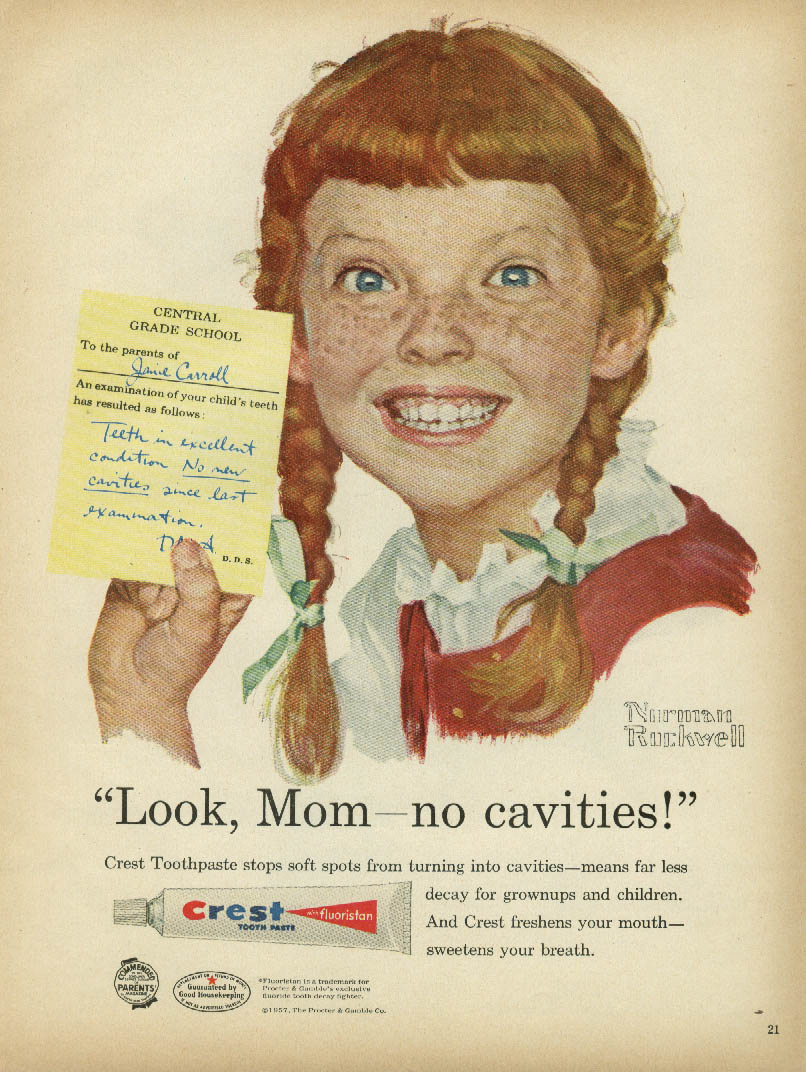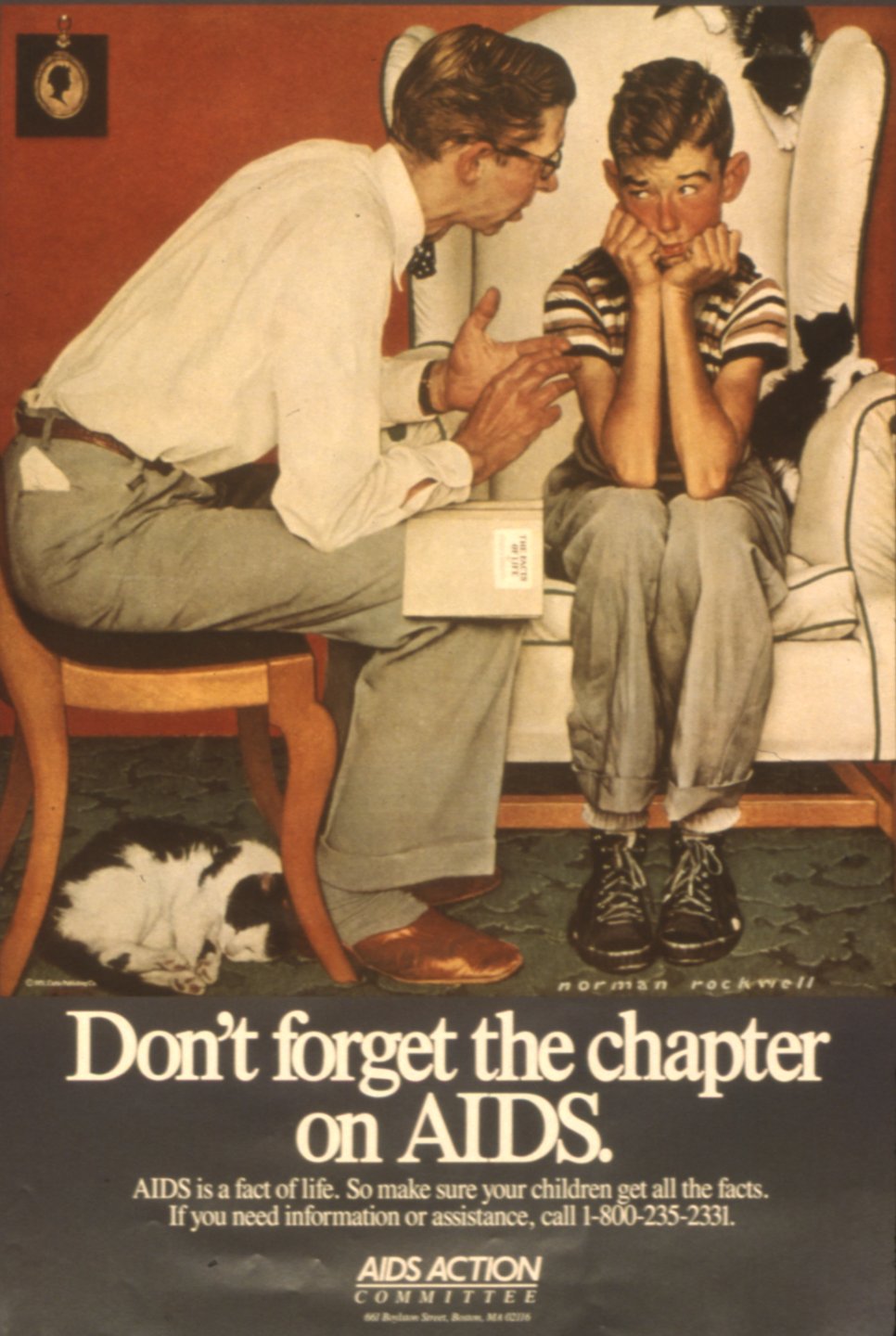Art and advertising advances science and health:
NORMAN ROCKWELL HELPED MAKE FLUORIDE TOOTHPASTE HISTORY
Now don't misunderstand us. We do not mean to say that art and advertising always advance science and health. Advertising is mostly in the business of selling products.
The Don Drapers and Peggy Olsons of the world are not normally paid to promote science.
If they were, there would not be ads for cellulite creams all over the place (because those creams have no evidence). L'Oreal would not have settled with the FTC for deceptive anti-aging ads, making false claims, and implying their cosmetics provide some sort of ridiculous gene therapy. And there would not have been two decades of the tobacco industry hiring actors to pretend to be doctors supporting smoking.
For sure, ad men and women come up with at least as much – if not more – shady pseudoscience B.S. as they make ads containing real science.
But sometimes, ads do play a role in advancing real science and true health promotion. And the history of fluoride in toothpaste is one of those times. Perhaps that's because art played such a key role in this piece of science history. Specifically, the art of Normal Rockwell.
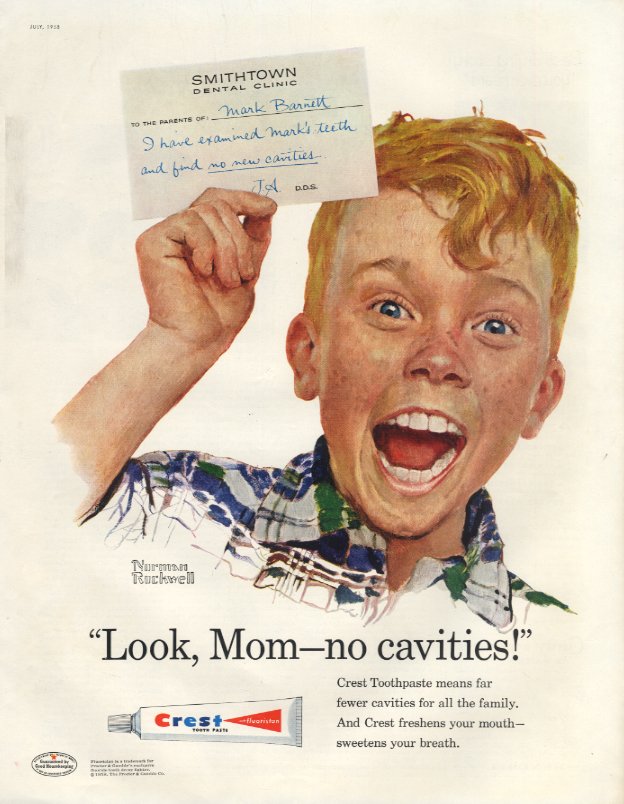
These famous ads featuring Rockwell's paintings of smiling kids were for Crest – the first fluoride toothpaste.
Kids in Rockwell's hometown of Stockbridge, Massachusetts modeled for the paintings starting in 1957. The ads began appearing in the same year, as early as August 1957 in publications such as McCall's and Parents' Magazine. And more of them ran in 1958 and 1959 in magazines like Good Housekeeping, Ladies Home Journal, and Better Homes and Gardens.
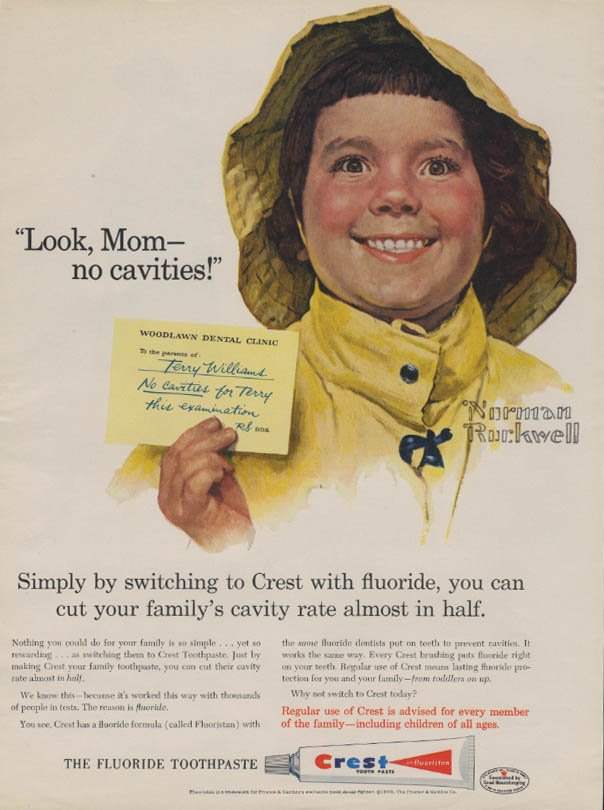
The ad campaign became famous, and remains famous today. And not just for Rockwell's art. The slogan "Look, Mom – no cavities!" is surely as well-remembered. At the time, the idea that kids across America could start coming home from the dentist with no new cavities was extremely new. And the experience of a cavity-free checkup was pretty much limited to cities that had just started fluoridating their drinking water a few years before the Rockwell ad campaign (or already had enough fluoride in water to prevent cavities). So the riff off of look-mom-no-hands was very memorable. And of course, even more well-known from these ads, is that name they came up with for the first toothpaste containing cavity-fighting fluoride. That name really endured ... because today, 120 million Americans brush with Crest toothpaste at least once a day. Everyone and their brother knows Crest toothpaste.
But the details of the place that these ads hold in the science history? Not so well-known ... even though those details are fascinating ... and even though the history here is a study in ads advancing science instead of holding science back.
How were the ads for the first fluoride toothpaste promoting science?
How indeed? Especially when so many other ads work against science!
Well, to begin with, these ads were created on a foundation of genuine high-quality years-in-the-making research studies.
First, there had been a ton of scientific investigation showing that fluoride in water prevented cavities – and this work was done by scores of bona fide actual public health dentists and chemists working in the Public Health Service, and in public universities such as the University of Michigan. So before the toothpaste researchers even got started on trying to make and test a toothpaste containing fluoride, they were building on a mountain of research on fluoride in water reducing tooth decay.
And then the toothpaste itself that Rockwell was commissioned to paint for was also developed by real actual dentists and chemists. While they were eventually funded by a company (Procter and Gamble), the scientists who did the work of getting fluoride into an effective toothpaste form ... those scientists were first and foremost working for the public good in a public university.
Not only that, but the whole research program that led to the first effective fluoride toothpaste formula and Rockwell's paintings was started by F'in graduate students :) ... Young, starry-eyed, gonna-change-the-world-with-science graduate students.
Crest's toothpaste with fluoristan: born from Hoosier state science
Joseph Muhler was the main guy. And Indiana University was the main place (go Hoosiers!).
It is actually amazing that Joseph Muhler ended up becoming one of the most accomplished preventive dentists and dental biochemists of all time ... and the inventor of Crest toothpaste ... and the raison d'être behind Norman Rockwell painting a bunch of adorable kids' smiles ... and the powerhouse researcher whose discovery turned Indiana University into one of the best dental research institutions in the U.S. ... because Joseph Muhler didn't even want to go to dental school.
In 1944, his draft card came up, and when he was like, "Hey, I'd really like to go to med school and ... be a Navy doctor?" the Navy was like, "Nope, we need dentists. You're goin' to dental school." And then!!! the! war! ended! and the Navy was like, "K, you're on your own now. We don't need you anymore, and we're not paying for the rest of this whole dental school thing."
But Muhler ... with help from his major professor ... he had some ideas.
Some ideas inspired by all the research on fluoride in water. Fluoride which naturally occurred in water at varying levels caused different cities around the country to have different levels of tooth decay. But what about fluoride in different forms? Were other fluoride compounds effective in preventing tooth decay, too?
These ideas and questions led to some grants. Grants to research fluoride salts!
In 1945, in the middle of finishing up dental school, at age 23, Muhler started the 10-year research program that would eventually lead to him and his colleagues developing the world's first effective toothpaste – using stannous fluoride as the main anti-cavity ingredient.
During those 10 years, he also finished up dental school to get his D.D.S., and then got his Ph.D. in chemistry. He published and presented his promising findings on stannous fluoride at scientific conferences, where he caught the attention of Procter and Gamble researchers who were not having any luck with developing their own fluoride toothpaste. He then negotiated grant funding from Procter and Gamble. And he became a research professor ... all at the state university, first in Indianapolis, and then in Bloomington, Indiana.
Toothpaste tests ... first in the lab...
Then, on to small mammals (i.e. rodents & children)
The research itself first involved getting in the lab and grinding up donated extracted teeth from patients. Then he tested all kinds of different fluoride salts on the ground up teeth, to see how well the different kinds of fluoride helped enamel hold up against acetic acid. Muhler found that stannous fluoride was twice as effective at protecting enamel in the lab as was sodium fluoride.
Then Muhler and colleagues moved on from managing hundreds of fluoride salts and tooth enamel samples to managing 1200 rats and "a small army of hamsters." Ah, science! Sometimes it is not so glamorous, and instead involves ... a lot of animal poop ... and special mini toothbrushes for brushing hundreds of little lab rats' teeth every single day. As if one's own oral hygiene responsibilities aren't enough! Studying how well the stannous fluoride formula worked on preventing cavities in rats and hamsters meant a whole lot of cage-cleaning and animal care and being sure to feed them food that causes cavities. The small mammals got a "cariogenic" diet – in other words, the same kind of stuff we like to eat that causes cavities, like sweet, sweet sugar. But those little rat and hamster teeth that got treated with stannous fluoride? The fluoride came to the rescue and cut their rate of decay, compared to the control compounds.
Another break-through came from another grad student ... this time doing what one does best as a grad student ... F'ing up! :) ... Just like F itself, F'ing up in science actually does good things. William Nebergall accidentally baked the typical toothpaste ingredients of the time overnight. Baking it that long turned the calcium phosphate abrasive into calcium pyrophosphate, which was much more compatible with fluoride than the ingredients everyone had been trying to pair with fluoride into a toothpaste. No longer would the ingredients that made the toothpaste pasty bind with all of the fluoride and render it into an inactive ingredient. Calcium pyrophosphate let 50% of the fluoride remain available to fight cavities.
Now once you figure out which combo of ingredients allow the fluoride to still work when it is all mixed up into a toothpaste formula ... and you show your favorite fluoride salt fights cavities in cute little animals? Next step! Tooth brushing experiments on cute little kids, of course!
Muhler and colleagues tested the stannous fluoride-calcium pyrophosphate formula in three doubleblind, controlled trials.
Over 3600 kids and adults in Bloomington, Indiana, officially participated in the clinical trials. Plus, 7900 family members also brushed with the control and treatment toothpastes, to make sure there wasn't any other toothpaste in the house competing for the study subject's tooth brushing needs. All told, nearly a third of the town of Bloomington participated in the study as a research subject or a supporting family member.
And man, those cute little kids who were the study subjects so crucial to the science that led to Crest's fluoride toothpaste being promoted by Norman Rockwell's portraits of cute little kids? Those real life kids looked an awful lot like Rockwell's paintings.
F'in check this out ... Collier's Magazine did a feature on Muhler's research in 1956 and included pictures of some of the kids who actually participated in the clinical trials.


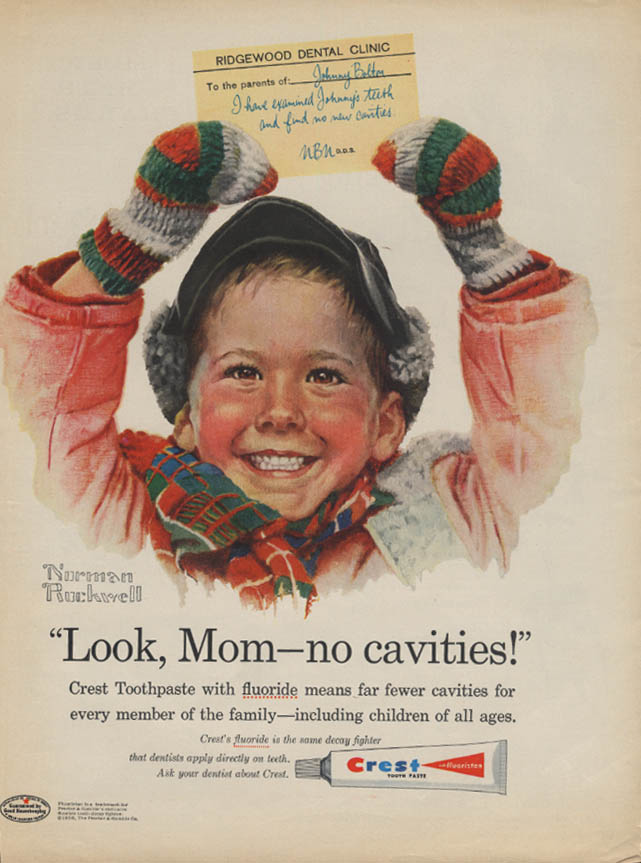
But it gets even better ... check out the other Collier's photo of kids in the waiting room of Muhler's clinic. The clinic where the 3600 volunteers in the experiments got their control and treatment tubes of toothpaste, their dental exams, and X-rays. Norman Rockwell did *not* in fact paint any of the kids who actually participated in the study. He did *not* walk into this waiting room to paint all the Look Ma No Cavities kids straight out of the study, but man, this waiting room sure looks like they could of been Normal Rockwell's models.

Don't believe us? Flip through the rest of the Normal Rockwell Crest ads below. Rockwell's models were from Rockwell's hometown of Stockbridge, Massachusetts, nearly 900 miles away from where the study took place in Bloomington. But dang, Rockwell's models in Stockbridge sure looked a lot like those Bloomington, Indiana kids above who were actually in the research study ...

OK, so that's super fun to see how much these kids in Rockwell's ads looked like the kids who participated in the study. But what about all the claims in the Rockwell ads about fewer cavities with Crest and cutting a family's cavity rate in half? Is that what Muhler's research really showed?
It did indeed. By 1960, between the early research in the lab and the later clinical trials, Muhler and colleagues had published 90 papers in premier journals – the Journal of the American Dental Association, the Journal of Dental Research, the Journal of Nutrition, and Science. And findings in their main clinical study prior to the ads did show a 50% reduction in cavities – in children and adults.
Muhler and colleagues patented the formula and licensed it to Procter and Gamble. Procter and Gamble then led up the business side of things – like the ads, naming it Crest, calling the new stannous fluoride compound "Fluoristan" to make it catchy, and selling it in test markets like Portland, Oregon (our fair city!) before rolling it out nationwide. Muhler and colleagues donated half of the royalties to the Indiana University Foundation, ensuring that this scientific discovery funded even more dental science at Indiana University for decades to come.
Ah, but! Before those decades of Crest royalties got re-invested into more and more science for the public good, people had to start buying it. And that's where things get really interesting with the role of the Rockwell ads in the science history. As famous as Norman Rockwell's art made the new Crest toothpaste with Fluoristan, it wasn't actually enough to get people to buy it. Toothpaste ads had had a long history of making false claims, so people were skeptical – even though these ads were in fact conveying real science.
When Norman Rockwell isn't enough and you need ADA science
What really advanced health and made people switch to the new fluoride toothpaste was the American Dental Association. In 1960, ADA had seen enough of the published research findings that their Council on Dental Therapeutics gave Crest the ADA's first seal of acceptance. As the world's premier dental science organization, as the publisher of the most important peer-reviewed dental journal in the world, ADA had evaluated Muhler's team's work and concluded Crest was effective.
The ADA let Proctor and Gamble use the following statement on their new toothpaste, "Crest has been shown to be an effective decay-preventive dentifrice that can be of significant value when used in a conscientiously applied program of oral hygiene and regular professional care."
Ha, at first glance, whew, that is not nearly as catchy as "Look Mom – no cavities!"
But the public – seeing that the scientists and dentists agreed that this time the claims were really honestly supported by the science – Crest took off and became America's #1 toothpaste.
And it gets even more interesting in the twists and turns at this point. Of course it does, because it was the 1960s, and the times, they were a-changin! It was time for Crest to keep advancing, too.
One way the ads advanced is by getting with it in recognizing the relevance of advertising to all Americans, regardless of race. All kinds of American moms are looking to keep their sons' and daughters' teeth healthy. And all kinds of Indiana University students and Bloomington residents participated in the research.
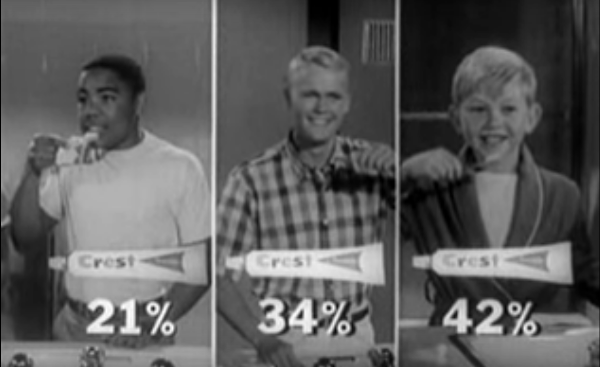
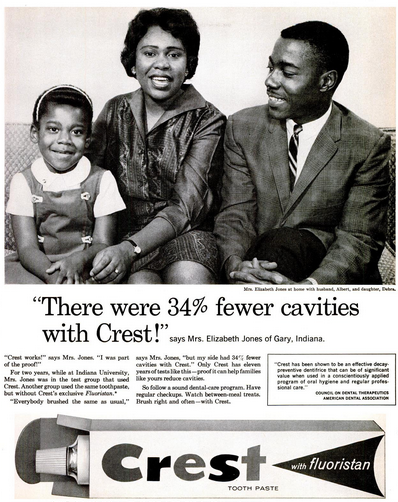
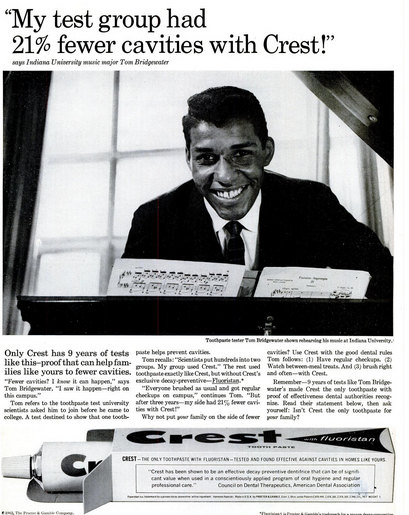
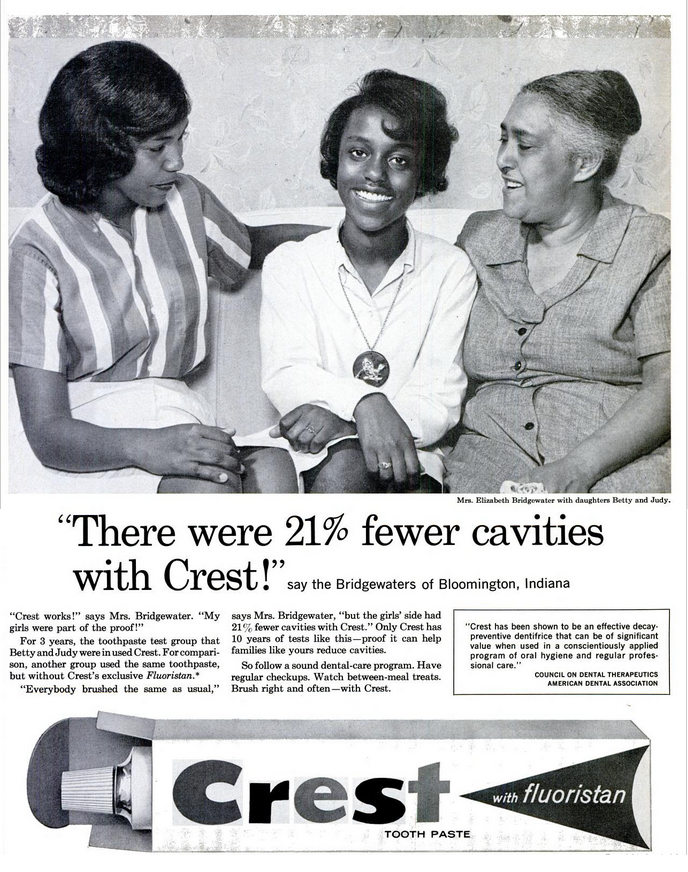
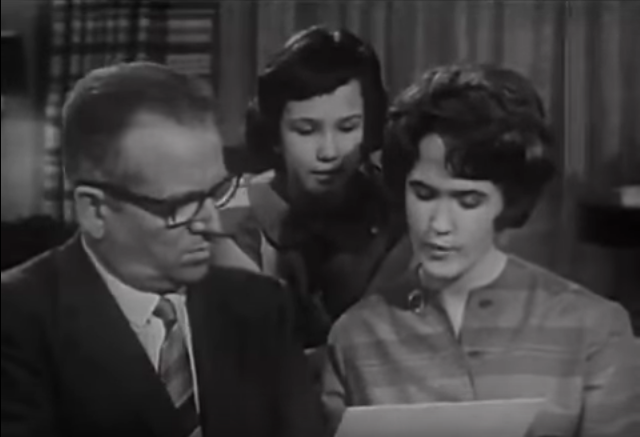
And another way the ads advanced? In return for ADA's stamp of approval ... Crest had to agree to stop using the "Look Mom – no cavities!" slogan! And allow ADA to approve all ad copy!!!
Because ADA, ever the careful scientific organization unwilling to overstate things, thought the no cavities slogan implied a little too big of a promise compared to the data. Fewer cavities, yes. Significant value, yes. But no cavities? They weren't so sure about that.
Business historians discuss this history as a remarkable business accomplishment. Proctor and Gamble getting ADA's seal on their product propelled Crest to become the number one toothpaste in America by 1962. But we think this was an amazing achievement for science on two counts – a toothpaste that actually worked and was proven effective using science, and ads having to go through peer review? Whoa. THAT is amazing.
So under ADA's big red science editing pen, Crest moved to highlighting numbers from continued tests – 21%, 34%, 42% fewer cavities. And when they did a nostalgic ad bringing one of the Norman Rockwell kids back in 1974, they left off the "Look Mom – no cavities!" slogan.
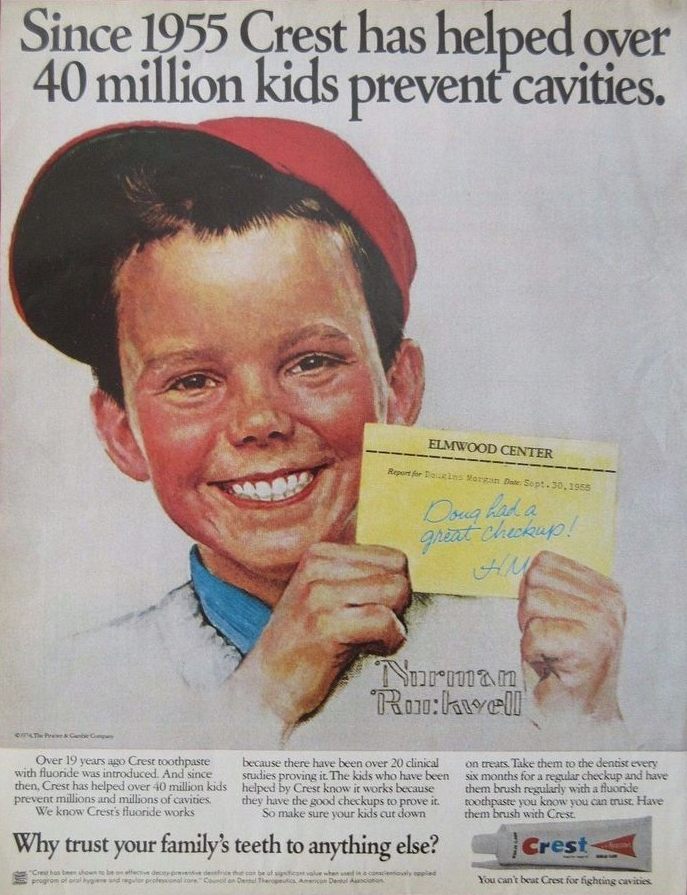
However ... we think it's time for a revival of Norman Rockwell's health- and dental-related art and the famous Crest slogan ... for the sake of science.
Health was a theme in many Rockwell paintings
Today, dental science and prevention has advanced to the point that kids and adults coming home from checkups with no new cavities is actually a pretty regular occurrence. Before the development of fluoride toothpaste by Indiana University scientists, a checkup with no cavities was practically unheard of. Some of our best data on rates of tooth decay from the 1930s showed 95% of 15-year-olds in a representative U.S. city had tooth decay. And one out of five 10-year-olds had a permanent tooth pulled because of cavities – missing, gone, forever. Today, two out of every five American teenagers have had no tooth decay AT ALL in ANY of their permanent teeth.
Fluoride in toothpaste is not the only factor in such progress in cavity prevention. Water fluoridation, fluoride varnish, better nutrition, and sealants are some of the many other science and public health developments that are now all fighting the good fight against tooth decay together.
We also have a lot more work to do to get to the point where all kids come home from most checkups with "no cavities." (See EndCavities.org for one effort to get us to that ultimate goal! 5 out of 5 teenagers with NO tooth decay!)
But toothpaste containing ADA's recommended amount of fluoride plays a key role in all the checkups at which dentists are giving patients – from the littlest kids to the oldest adults – the all-clear. And for that, we think Norman Rockwell deserves some of the credit. And we think Norman Rockwell's art, and the role his smiling kids had in making the first fluoride toothpaste a household name, is relevant to our understanding of fluoride and cavity prevention today.
